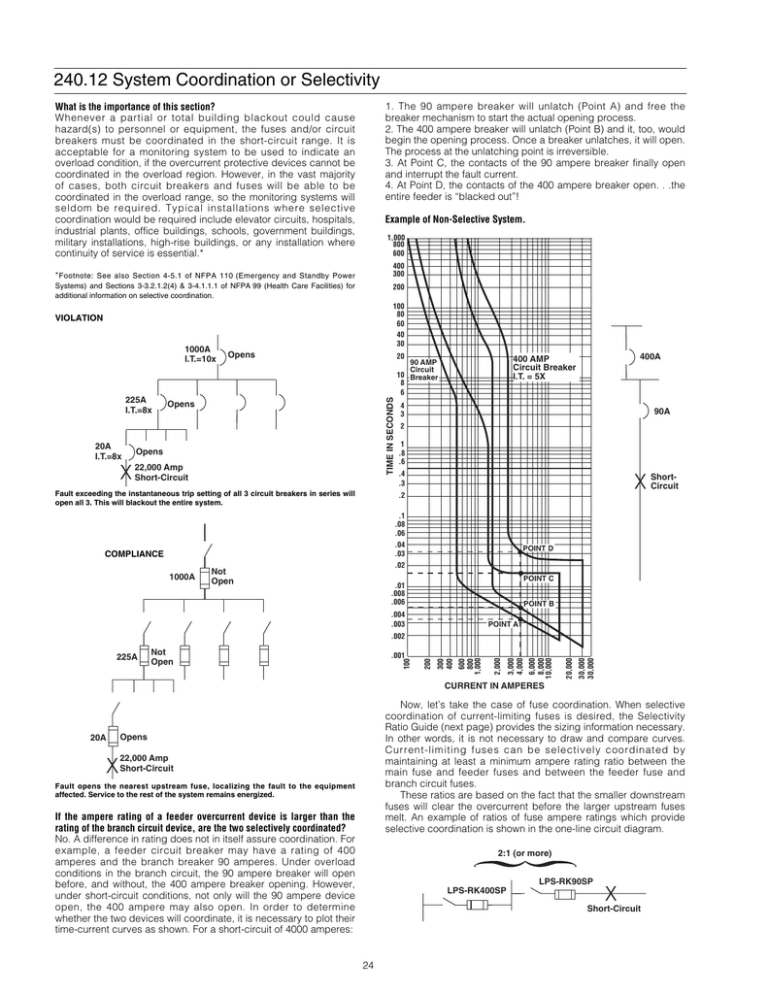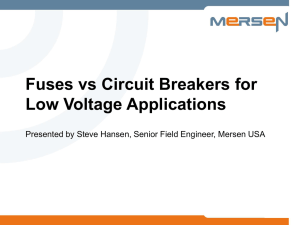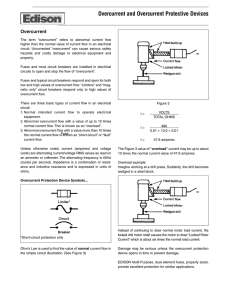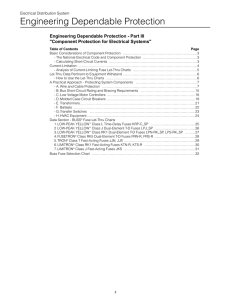240.12 System Coordination or Selectivity
advertisement

240.12 System Coordination or Selectivity 1. The 90 ampere breaker will unlatch (Point A) and free the breaker mechanism to start the actual opening process. 2. The 400 ampere breaker will unlatch (Point B) and it, too, would begin the opening process. Once a breaker unlatches, it will open. The process at the unlatching point is irreversible. 3. At Point C, the contacts of the 90 ampere breaker finally open and interrupt the fault current. 4. At Point D, the contacts of the 400 ampere breaker open. . .the entire feeder is “blacked out”! What is the importance of this section? Whenever a partial or total building blackout could cause hazard(s) to personnel or equipment, the fuses and/or circuit breakers must be coordinated in the short-circuit range. It is acceptable for a monitoring system to be used to indicate an overload condition, if the overcurrent protective devices cannot be coordinated in the overload region. However, in the vast majority of cases, both circuit breakers and fuses will be able to be coordinated in the overload range, so the monitoring systems will seldom be required. Typical installations where selective coordination would be required include elevator circuits, hospitals, industrial plants, office buildings, schools, government buildings, military installations, high-rise buildings, or any installation where continuity of service is essential.* Example of Non-Selective System. 1,000 800 600 400 300 * Footnote: See also Section 4-5.1 of NFPA 110 (Emergency and Standby Power Systems) and Sections 3-3.2.1.2(4) & 3-4.1.1.1 of NFPA 99 (Health Care Facilities) for additional information on selective coordination. 200 100 80 60 40 30 VIOLATION 225A I.T.=8x 20A I.T.=8x Opens 20 Opens Opens 22,000 Amp Short-Circuit Fault exceeding the instantaneous trip setting of all 3 circuit breakers in series will open all 3. This will blackout the entire system. 4 3 90A 2 1 .8 .6 .4 .3 ShortCircuit .2 .1 .08 .06 .04 .03 COMPLIANCE 1000A 400A 400 AMP Circuit Breaker I.T. = 5X 90 AMP Circuit 10 Breaker 8 6 TIME IN SECONDS 1000A I.T.=10x POINT D .02 Not Open POINT C .01 .008 .006 POINT B .004 .003 POINT A 30,000 30,000 20,000 6,000 8,000 10,000 3,000 4,000 2,000 600 800 1,000 .001 300 400 Not Open 100 225A 200 .002 CURRENT IN AMPERES 20A Now, let’s take the case of fuse coordination. When selective coordination of current-limiting fuses is desired, the Selectivity Ratio Guide (next page) provides the sizing information necessary. In other words, it is not necessary to draw and compare curves. Current-limiting fuses can be selectively coordinated by maintaining at least a minimum ampere rating ratio between the main fuse and feeder fuses and between the feeder fuse and branch circuit fuses. These ratios are based on the fact that the smaller downstream fuses will clear the overcurrent before the larger upstream fuses melt. An example of ratios of fuse ampere ratings which provide selective coordination is shown in the one-line circuit diagram. Opens 22,000 Amp Short-Circuit 19-B Fault opens the nearest upstream fuse, localizing the fault to the equipment affected. Service to the rest of the system remains energized. If the ampere rating of a feeder overcurrent device is larger than the rating of the branch circuit device, are the two selectively coordinated? No. A difference in rating does not in itself assure coordination. For example, a feeder circuit breaker may have a rating of 400 amperes and the branch breaker 90 amperes. Under overload conditions in the branch circuit, the 90 ampere breaker will open before, and without, the 400 ampere breaker opening. However, under short-circuit conditions, not only will the 90 ampere device open, the 400 ampere may also open. In order to determine whether the two devices will coordinate, it is necessary to plot their time-current curves as shown. For a short-circuit of 4000 amperes: 2:1 (or more) LPS-RK90SP LPS-RK400SP Short-Circuit 24 240.12 System Coordination or Selectivity *Selectivity Ratio Guide (Line-Side to Load-Side) for Blackout Prevention. Circuit Current Rating Type Trade Name & Class Line-Side Fuse 601 to 6000A 601 to 4000A 0 to 600A 601 to 6000A 0 to 600A 0 to 1200A 0 to 600A 0 to 60A Buss Symbol Time- LOW-PEAK® KRP-C–SP Delay YELLOW™ (L) Time- LIMITRON® KLU Delay (L) LOW-PEAK® LPN-RK–SP YELLOW™ LPS-RK–SP Dual (RK1) Ele(J) LPJ–SP** ment FUSETRON® FRN-R (RK5) FRS-R LIMITRON® KTU (L) Fast- LIMITRON® KTN-R Acting (RK1) KTS-R T-TRON® JJN (T) JJS LIMITRON® JKS (J) Time- SC SC Delay (G) Load-Side Fuse 601-6000A 601-4000A TimeTimeDelay Delay LOW-PEAK® LIMITRON® YELLOW™ (L ) (L ) 0-600A Dual-Element Time-Delay LOW-PEAK® YELLOW™ (RK1) 601-6000A Fast-Acting 0-1200A FUSETRON® LIMITRON® LIMITRON® T-TRON® 0-60A TimeDelay LIMITRON® SC (T) JJN JJS 2:1 (J) JKS (G) SC 2:1 (RK1) KTN-R KTS-R 2:1 2:1 N/A 2.5:1 2:1 (RK5) FRN-R FRS-R 4:1 2:1 2:1 2:1 2:1 4:1 2:1 2:1 2:1 2:1 N/A – – 2:1 2:1 8:1 – 3:1 3:1 3:1 4:1 – – – – 2:1 1.5:1 2:1 1.5:1 8:1 2:1 – – 3:1 1.5:1 3:1 1.5:1 3:1 1.5:1 4:1 1.5:1 2:1 2.5:1 2:1 2:1 6:1 2:1 2:1 2:1 2:1 N/A – – 3:1 3:1 8:1 – 3:1 3:1 3:1 4:1 – – 3:1 3:1 8:1 – 3:1 3:1 3:1 4:1 – – 2:1 2:1 8:1 – 3:1 3:1 3:1 4:1 – – 3:1 3:1 4:1 – 2:1 2:1 2:1 2:1 KLU 2:1 (L ) KTU 0-600A LPN-RK–SP LPS-RK–SP 2:1 KRP-C–SP (J)** LPJ–SP 0-600A Fast-Acting lowered to permit closer fuse sizing. Plot fuse curves or consult with Bussmann. * Note: At some values of fault current, specified ratios may be ® General Notes: Ratios given in this table apply only to Buss fuses. When fuses are within the same case size, consult Bussmann. ** Consult Bussmann for latest LPJ—SP ratios. . 240.13 Ground Fault Protection of Equipment on Buildings or Remote Structures What does this section require? Equipment ground fault protection of the type required in 230.95 is required for each disconnect rated 1000 amperes or more in 480Y/277V solidly grounded systems that will serve as a main disconnect for a separate building or structure. Refer to 215.10 and 230.95. High Voltage Service G.F.P. Not Required Building A 800A 480Y/277V G.F.P. Not Required Building B Note: G.F.P. that is not current-limiting may not protect system components. See 110.10 and 250.1 (FPN). 1000A or Greater 480Y/277V G.F.P. Required 240.21 Location Requirements for Overcurrent Devices and Tap Conductors made to a switchboard bus for an adjacent panel, such as an emergency panel, the use of cable limiters is recommended as supplementary short-circuit protection of the tapped conductor. These current-limiting cable limiters are available in sizes designed for short-circuit protection of conductors from 12 AWG to 1000 kcmil. They provide current-limiting short-circuit protection but not overload protection. 240.21 Location in Circuit Requires overcurrent protection to be provided in each ungrounded circuit conductor and be located at the point where the conductors receive their supply except as specified in 240.21(A)-(G). No conductor supplied per 240.21(A)-(G) shall supply another conductor, except through an overcurrent device meeting the requirements of 240.4. In other words, “you can’t tap a tap!” The most common use of tap conductors for feeders, 240(B), and transformer secondary conductors, 240(C), are the 10 foot, 25 foot and outside tap conductor rules. It is important to realize that although they allow for unprotected lengths of conductors, in almost all cases, termination in a single or group of overcurrent protection devices is required. In addition, it may be necessary to meet other requirements for panelboards, 408.16, and transformers, 450.3. Note: Smaller conductors tapped to larger conductors can be a serious hazard. If not adequately protected against short-circuit conditions (as required in 110.10 and 240.1), these underprotected conductors can vaporize or incur severe insulation damage. Molten metal and ionized gas created by a vaporized conductor can envelop other conductors (such as bare bus), causing equipment burn-down. Adequate short-circuit protection is recommended for all conductors. When a tap is 25




